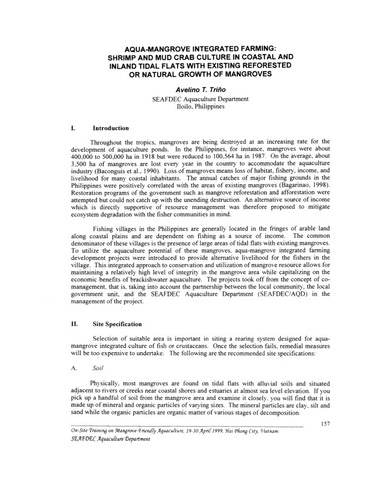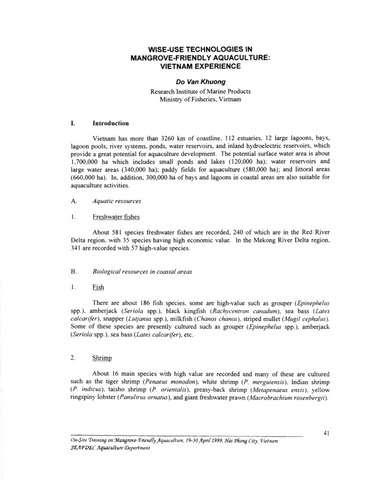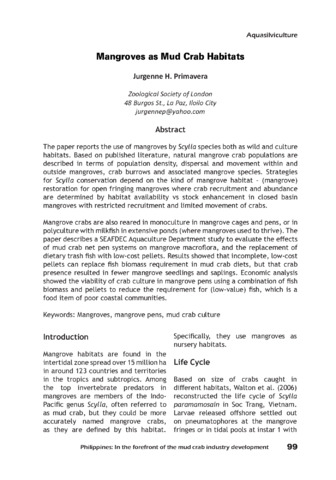Aqua-mangrove integrated farming: Shrimp and mud crab culture in coastal and inland tidal flats with existing reforested or natural growth of mangroves
Share
นามธรรม
Throughout the tropics, mangroves are being destroyed at an increasing rate for the development of aquaculture ponds. In the Philippines, for instance, mangroves were about 400,000 to 500,000 ha in 1918 but were reduced to 100,564 ha in 1987. On the average, about 3,500 ha of mangroves are lost every year in the country to accommodate the aquaculture industry (Baconguis et al., 1990). Loss of mangroves means loss of habitat, fishery, income, and livelihood for many coastal inhabitants. The annual catches of major fishing grounds in the Philippines were positively correlated with the areas of existing mangroves (Bagarinao, 1998). Restoration programs of the government such as mangrove reforestation and afforestation were attempted but could not catch up with the unending destruction. An alternative source of income which is directly supportive of resource management was therefore proposed to mitigate ecosystem degradation with the fisher communities in mind.
Fishing villages in the Philippines are generally located in the fringes of arable land along coastal plains and are dependent on fishing as a source of income. The common denominator of these villages is the presence of large areas of tidal flats with existing mangroves. To utilize the aquaculture potential of these mangroves, aqua-mangrove integrated farming development projects were introduced to provide alternative livelihood for the fishers in the village. This integrated approach to conservation and utilization of mangrove resource allows for maintaining a relatively high level of integrity in the mangrove area while capitalizing on the economic benefits of brackishwater aquaculture. The projects took off from the concept of co-management, that is, taking into account the partnership between the local community, the local government unit, and the SEAFDEC Aquaculture Department (SEAFDEC/AQD) in the management of the project.
การอ้างอิง
Triño, A. T. (2000). Aqua-mangrove integrated farming: Shrimp and mud crab culture in coastal and inland tidal flats with existing reforested or natural growth of mangroves. In Y. Tadokoro, V. T. Sulit, & R. B. Abastillas (Comps.), Technologies in Mangrove-Friendly Aquaculture. Final Report of and Papers Presented to the On-Site Training on Mangrove-Friendly Aquaculture, Hai Phong City, Socialist Republic of Vietnam, 19-30 April 1999 (pp. 157–188). Tigbauan, Iloilo, Philippines: Aquaculture Department, Southeast Asian Fisheries Development Center.
เรื่อง
macrophytes  ; agropisciculture
; agropisciculture  ; mangroves
; mangroves  ; aquaculture
; aquaculture  ; shrimp culture
; shrimp culture  ; crab culture
; crab culture  ; tidal flats
; tidal flats  ; pond construction
; pond construction  ; feeds
; feeds  ; feeding
; feeding  ; aquaculture systems
; aquaculture systems  ; harvesting
; harvesting  ; investment
; investment  ; stocking density
; stocking density  ; monoculture (aquaculture)
; monoculture (aquaculture)  ; extensive aquaculture
; extensive aquaculture  ; intensive aquaculture
; intensive aquaculture  ; fry
; fry  ; water quality
; water quality  ; Scylla serrata
; Scylla serrata  ; Scylla tranquebarica
; Scylla tranquebarica  ; Scylla olivacea
; Scylla olivacea 
 ; agropisciculture
; agropisciculture  ; mangroves
; mangroves  ; aquaculture
; aquaculture  ; shrimp culture
; shrimp culture  ; crab culture
; crab culture  ; tidal flats
; tidal flats  ; pond construction
; pond construction  ; feeds
; feeds  ; feeding
; feeding  ; aquaculture systems
; aquaculture systems  ; harvesting
; harvesting  ; investment
; investment  ; stocking density
; stocking density  ; monoculture (aquaculture)
; monoculture (aquaculture)  ; extensive aquaculture
; extensive aquaculture  ; intensive aquaculture
; intensive aquaculture  ; fry
; fry  ; water quality
; water quality  ; Scylla serrata
; Scylla serrata  ; Scylla tranquebarica
; Scylla tranquebarica  ; Scylla olivacea
; Scylla olivacea 
Taxonomic term
คอลเลกชัน
รายการที่เกี่ยวข้อง
แสดงรายการที่เกี่ยวข้องตามชื่อผู้แต่งผู้สร้างและเรื่อง
-
European Union's special project on mudcrab
Castaños, Milagros T.; Southeast Asian Fisheries Development Center, Aquaculture Department (Aquaculture Department, Southeast Asian Fisheries Development Center, 2003) -
Wise-use technologies in mangrove-friendly aquaculture: Vietnam experience
Khuong, Do Van (Aquaculture Department, Southeast Asian Fisheries Development Center, 2000)This report refers to the status of aquaculture technologies in coastal areas in general. Some mangrove-friendly aquaculture systems in Vietnam are also discussed including several measures to develop aquaculture in mangroves ... -
Mangroves as mud crab habitats
Primavera, Jurgenne (Aquaculture Department, Southeast Asian Fisheries Development Center, 2017)The paper reports the use of mangroves by Scylla species both as wild and culture habitats. Based on published literature, natural mangrove crab populations are described in terms of population density, dispersal and ...





